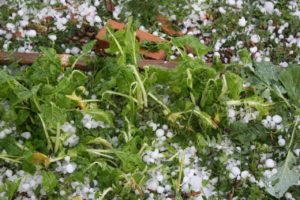This spring has brought with it a few record setting weather phenomenon down here in southwest Virginia. February and March’s warm weather was followed by April, May’ and June’s never ending showers. As gardeners, so much of our success and failure depends on Mother Nature. There are a few steps we can take to protect our soil and plants, but other times, we have to set back and watch it hail. Here are a few tips for what to do after heavy rains and thunderstorms.

Hail damage.
- Take note of any plant damage. It is always good practice to know what’s going on in your garden. You should always take a survey of plants to see what pest damage they may be facing. After a thunderstorm with heavy rain or hail, remove leaves with major damage, stake or tie plants that may be leaning, provide extra support by adding compost or mulch around the base of plants especially if you see exposed roots, and lastly, if the plant has major damage, like a broken stem, call it a loss and remove it from your garden.
- Avoid over working saturated soil. As gardeners, we want to spend time in our happy place, especially after we have spent the last few rainy days locked away. However, we should let the garden dry out some before we try to work in it. Tilling or hoeing saturated soil can do more damage than good. Soil impaction from walking or working in wet soil can limit root growth. One way to help your garden dry out faster is to build raised beds. At Sprouting Hope’s community garden we have raised beds that only need a day to dry out before we can begin working in them again. They also provide clearly marked pathways, so it’s easier for our volunteers to move around in the garden.
- Check the forecast to adjust your fertilizing and spraying schedule. Sometimes we get in the habit of doings things based on patterns, convenience, or simply because we don’t have a lot of time to spare. However, we should adjust our fertilizing and spraying schedule to accommodate the weather. It’s a waste of money and resources to feed our pants organic fertilizer only to see it wash away. Check the weather, if you have a 24 hour period without rain, you’re in the clear. Also, heavy water runoff can carry nutrients from the soil, so make sure you replenish with a fish emulsion or some other organic fertilizer. These fertilizer’s come with great instructions, so make sure to read them before application.
- Be proactive to stop the spread of fungal and bacterial diseases. As much as you get tried of all the rain, fungal and bacterial diseases love the damp, humid conditions. In my opinion, it isn’t enough to keep an eye out for these diseases because once they are in your garden, they are hard to control. At Sprouting Hope’s community garden our tomatoes are protected in a hoop house, but we still spray them on a regular schedule. We alternate every 7 days between a copper fungicide and Serenade. We hear a lot about blight and tomatoes, but other plants in the garden are receptive to these disease as well. Cucurbits can get powdery mildew which looks like powdery white or gray splotches on the leaves or stem. If you know the heavy rains are coming, it’s best to be proactive and spray the plants if there is a 24 hour period of dry weather. If you notice your plants have a disease, remove and destroy all infected parts. Do not compost any diseased plants or parts. Apply a fungicide. Again, read the label to be sure the type of plant and disease for best application. Also, be proactive, improve air circulation by thinning and pruning.
- Check in on your neighbors. Whether it’s through sharing the bounty, swapping tools and ideas, or sharing labor, gardening should always build community. After a heavy rain or major storm, check in with your neighbors. Your garden may have been spared from damage, but someone else’s may have been destroyed. Check to see if a neighbor or a friend needs help cleaning up or doing damage control. This isn’t just a friendly practice; often, what’s happening in another garden is soon to happen in your own. Diseases and pests can spread from garden to garden, so by checking in you’re learning if there is something you should be looking out for or proactively beginning to treat. Also, you never know when you may be faced with a major clean up and need your neighbors to come to the rescue.


Leave A Comment